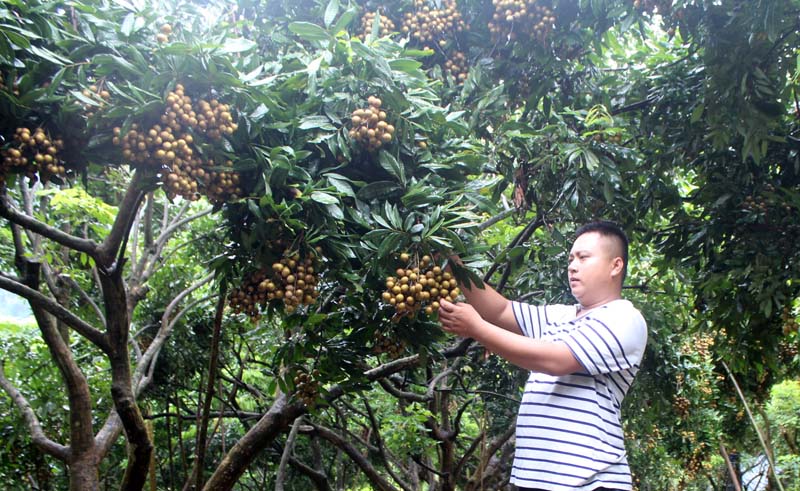
(HBO) – Farmers in Son Thuy commune, Kim Boi district, have been in a jubilant mood as their longan crop yields good results.
 Bui Van Dung and his family in Khoang commune, Son Thuy commune, invest
to cultivate clean longan to meet the market’s requirements.
Bui Van Dung and his family in Khoang commune, Son Thuy commune, invest
to cultivate clean longan to meet the market’s requirements.
Bui Thi Chien in Khoang commune said: "This year,
longan has been sold at good prices. From the beginning of the crop, my family
gained 35,000 VND per kilogramme, and now the prices range from 27,000 to
28,000 VND. We grew Huong Chi longan in an area of 2 hectares, and strictly
followed cultivating and caring techniques. Therefore, our trees have born rich
fruit. We are expecting to harvest some 35 tonnes of longan, and pocket around
800-900 million VND.
like Chien’s household, many farmers in Son Thuy commune are beaming with their
longan crops. Most of the longan areas have been grown with Huong Chi and Mien
varieties, which are suitable with local soil and weather conditions. In fact,
Huong Chi and Mien longans have brought high economic value to the growers, and
become staple crops of the locality.
According to Bach Cong Luong, Chairman of the Son Thuy commune People’s
Committee, the commune is now home to 140 hectares of longan and 200 hectares
of other fruit orchards. As Son Thuy longan was recognised as a collective
brand by the Ministry of Science and Technology’s Intellectual Property Office
of Vietnam in 2016, it has become more popular in the market.
The commune plans to cultivate
additional 3-5 hectares of longan to expand concentrated planting area, and is
carry out a programme to grow longan in line with VietGAP standard so as to
branch out its brand in the market while ensuring sustainable development. Bar
code registration will be implemented after the programme is completed, facilitating
origin traceability to enhance prestige of the growers, he said.
Around 80 percent of the households in Son Thuy commune have shifted to planting
longan due to its high economic value. Many farmers in Khoang and Loc commune
are ow owning 1-2 hectares of longan.
Dung, an agricultural extension official in the commune, said his family has
2,000 square metres of land under longan. The areas were previously used to
grow sugar cane, which earned him instable income. This year, the longan
orchard yielded some 7-8 tonnes, tripling the amount of last year’s crop.
"Due to fierce competition, my family has planted longan in accordance with
VietGAP standards, and we are working to develop the application of QR codes
for product traceability. The move aims to meet requirements of choosy
consumers, as well as increase value of Son Thuy longan”, he stressed.
Transformation of plant structure in general and shifting to the cultivation of
longan in particular has made significant contributions to alleviating poverty
in Son Thuy commune. Many locals have become rich thanks to longan cultivation.
Besides, the work plays an important role in helping Son Thuy complete its new-style
rural area building programme.
According to data from the Hoa Binh Provincial Party Committee, the industrial production index for the first six months of 2025 is estimated to have increased by 20% compared to the same period last year. This marks the highest year-on-year growth rate for this period since 2020.
In the first six months of 2025, Hoa Binh province’s export turnover was estimated at 1.145 billion USD, marking an 18.11% increase compared to the same period in 2024. Import turnover was estimated at $ 804 million, a 17.15% increase, which helped the province maintain a positive trade balance.
The lives of the ethnic minority farmers in Tan Lac district have gradually improved thanks to the new directions in agricultural production. This is a testament to the collective strength fostered through the professional associations and groups implemented by various levels of the district’s Farmers’ Union.
With the motto the "product quality comes first,” after nearly one year of establishment and operation, Muong village’s Clean Food Agricultural and Commercial Cooperative, located in Cau Hamlet, Hung Son Commune (Kim Boi district), has launched reputable, high-quality agricultural products to the market that are well-received by consumers. The products such as Muong village’s pork sausage, salt-cured chicken, and salt-cured pork hocks have gradually carved out a place in the market and they are on the path to obtaining the OCOP certification.
In the past, the phrase "bumper harvest, rock-bottom prices" was a familiar refrain for Vietnamese farmers engaged in fragmented, small-scale agriculture. But today, a new spirit is emerging across rural areas of Hoa Binh province - one of collaboration, organisation, and collective economic models that provide a stable foundation for production.
Maintaining growing area codes and packing facility codes in accordance with regulations is a mandatory requirement for agricultural products to be eligible for export. Recently, the Department of Agriculture and Environment of Hoa Binh province has intensified technical supervision of designated farming areas and packing facilities to safeguard the "green passport" that enables its products to access international markets.



 Bui Van Dung and his family in Khoang commune, Son Thuy commune, invest
to cultivate clean longan to meet the market’s requirements.
Bui Van Dung and his family in Khoang commune, Son Thuy commune, invest
to cultivate clean longan to meet the market’s requirements.